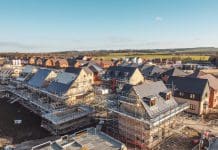Figures released today claim that house building has surged to the highest level since 2008 with Gloucestershire, South Derbyshire and South Norfolk amongst the strongest growth areas
The latest house building data from DCLG shows that 164,960 new homes were started in the year to June 2017, up 13% on the previous year, and have increased by more than three-quarters since the low in 2009.
More than 153,000 new homes have been completed during the same period, showing an increase of 11% compared with the year before.
The figures are based on building control inspection data, submitted to the department by local authorities, the National House Building Council and independent inspectors.
Housing and Planning Minister Alok Sharma said:
“Building more homes is an absolute priority for this government. Today’s figures are proof that we are getting Britain building again, with new housing starts reaching record levels since 2009.
“It’s vital we maintain this momentum to deliver more quality homes in the places that people want to live. Our housing white paper set out an ambitious package of long-term reforms to do just that.”
The figures suggest strong growth in house building across the country, with Gloucestershire, South Derbyshire and South Norfolk amongst the strongest areas in delivering high levels of starts.
This latest information should be a welcome relief showing that the government’s housing white paper, which set out bold plans to fix the broken housing market and build more homes across England, is making progress.
The Autumn Statement promised an additional £1.4 billion investment for the government’s affordable housing programme, increasing the total budget to £7.1 billion. Since 2010, almost 333,000 affordable homes have been delivered, including 240,000 affordable homes for rent.
However, James Allen, head of Walker Crips Alternative Investments, commented that:
“Today’s new house building figures should be met with cautious optimism even though the sector seems to be in generally good health. The trends for new house build starts and completions show that the market has recovered to pre-crisis levels. There is also significant convergence between the number of starts and completions which implies that there are few projects not being seen through to completion.
“The data is, however, no cause for real celebration as it belies the deeper issue of housing supply. There is a maximum capacity for new builds from the private sector and at c140,000 (85% of all new build starts) there is little room to increase activity. Housing associations have historically been able to deliver between 20,000-30,000 new units per annum so given they are currently producing c25,000 they will struggle to provide significantly more.
“The Barker Report, which reviewed land use planning in 2006, suggested that we need to create 209,000 new units per annum in order to keep pace with changing demographics and we have been well short of this figure every year since then.
“The most obvious way to address this dearth of supply is to give local authorities a mandate to once again build housing. Local authorities currently account for less than 1% of new housing. While I do not advocate a return to 1960’s type building schemes, a short term, five year plan to allow local authorities to borrow at cheap interest rates in order to rapidly address the housing shortage in target areas should not be considered political dogma. It is a sensible solution to a long term crisis.”













